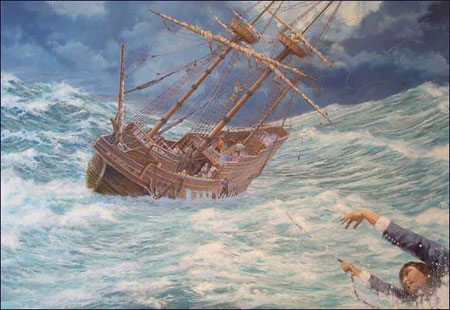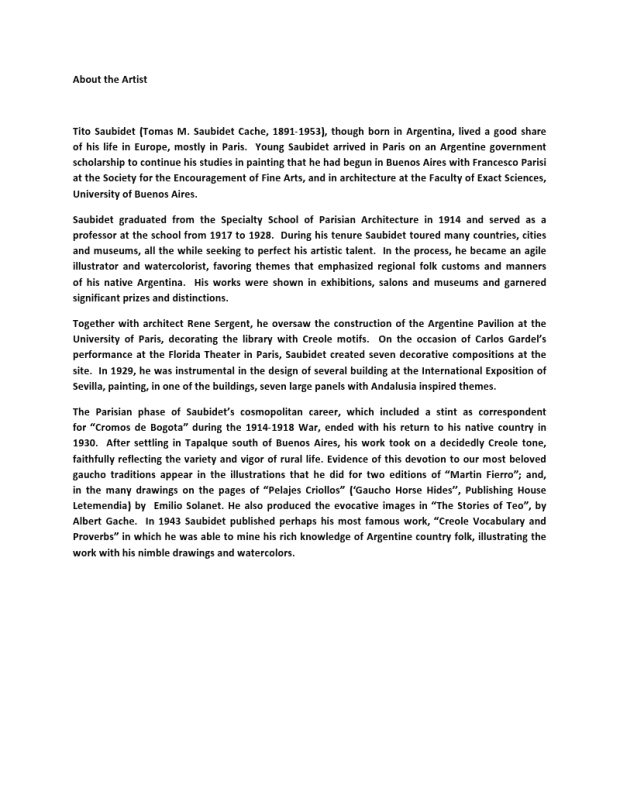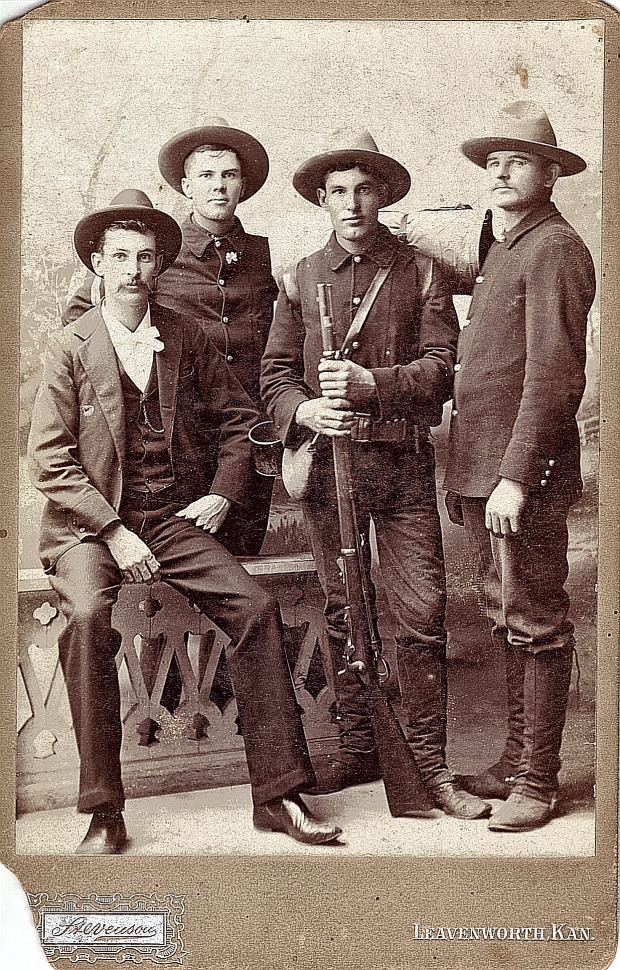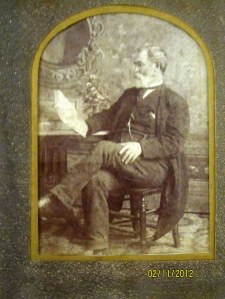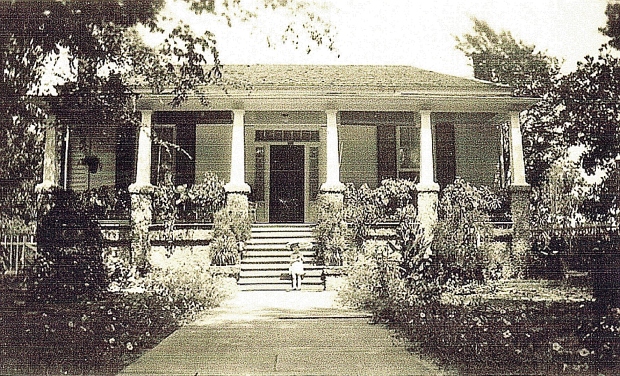Oops, I did it Again. . . 20 years later!
Oh my, 20 years ago I broke my right leg. Luckily, at that point, I was thinner, more mobile, and in better shape.
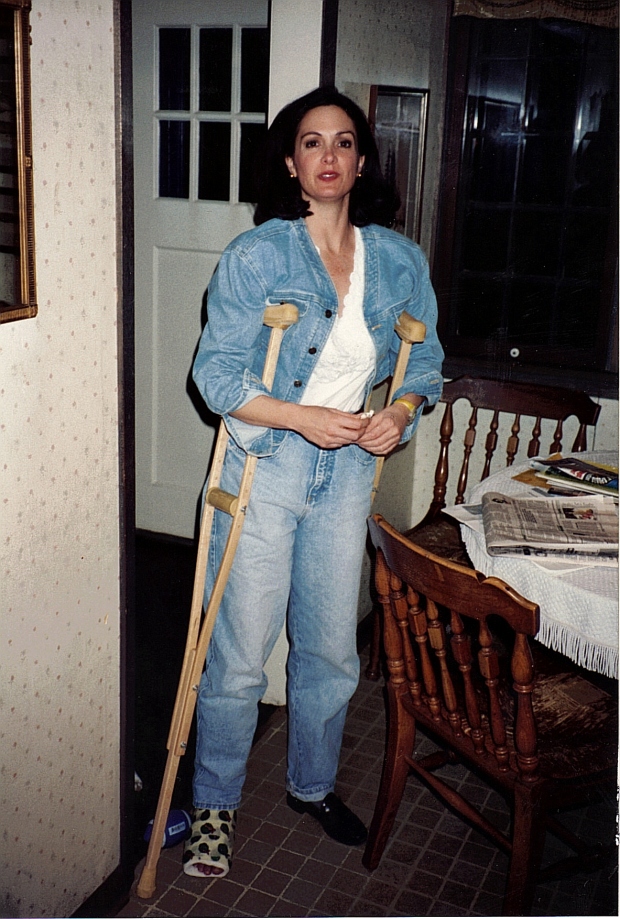
Last Monday night I did it again! I tripped in the basement and broke the left leg! I don’t have a “Teenage Ninja Turtle” cast yet. I’ll post a photo update after I see the Orthopedic Surgeon on Friday. Below is a photo of the ugly black walking boot I am currently wearing. I am stuck here at home with my leg elevated until I see the Orthopedic Surgeon and hear his opinion on what kind of cast I will need. I am hoping that they have updated their choices of cartoon characters. Bummer! I could never walk & chew gum. I probably score in the 99% of the world’s clumsiest people.

John Howland of the Mayflower
I finally got all of my documents copied and mailed to the Kansas Historian of the Mayflower Society. My Mayflower ancestor was John Howland.
John Howland of Fenstanton, Huntingdonshire, England was an adventurous young man who left his home before 1620 to seek fame and fortune in London. There he met a wealthy Londoner, Mr. John Carver, who was about to sail on the famous ship Mayflower, which left Plymouth, England in the autumn of 1620 bound for far away North America. Mr. Carver, who would be the first governor of New Plimoth Colony, hired John Howland as his indentured manservant.
John Howland of the Mayflower was called by Governor William Bradford “a lusty younge man.” He was one of the hired hands among the Mayflower company, being neither a “Saint”, as the Pilgrims were called, nor a “Stranger”, engaged for a specific duty, as was the soldier Captain Myles Standish. During the voyage across the North Atlantic, the Mayflower was buffeted by severe autumn storms during which she was forced to drop her sails and head into the wind, wallowing in the mountainous waves. John Howland ventured on deck and was washed overboard into the boiling sea. In Governor Bradford’s words “It pleased God that he caught hould of ye halliards which hunge over board, and rane out at length; yet he was held up. . .and then with a boat hooke and other means got into ye ship again.” It was this tenacity of purpose, perseverance, and the ability to deal with unexpected emergencies that helped John Howland to become a successful leader in the Plymouth community.
3rd Great Grandfather Chester Lamb, Boss Tweed and Tammany Hall
Since it is almost election day, I’ll thought I’d post something political that happened in 1875.
This postcard has nothing to do with 1875, but it was mailed in 1907. I found it today at our local Andover Antique Mall. There is an incredible stall at the antique mall that is filled with postcards, old “Life” magazines & other historical paper items.
My 3rd Great Grandfather Chester Lamb got caught up in Boss Tweed’s Tammany Hall escapades.
Chester Lamb (1816 – 1891)
is your 3rd great grandfather
William George Lamb (1842 – 1898)
Son of Chester
William Chester Lamb (1878 – 1946)
Son of William George
Florence Adele Lamb (1903 – 1984)
Daughter of William Chester
Grace Adele Britt (1928 – 1975)
Daughter of Florence Adele
Janet K. Page (aka Ellen Britt)
You are the daughter of Grace Adele
The following is an article from the “New York Daily Tribune“, Wednesday, December 8, 1875. Chester Lamb was also before the Grand Jury and closely questioned for providing carriages for the Tweed Party’s escape. Chester Lamb had a livery stable in New York City. (please see earlier posts about dear Grandfather Chester)
The following is a quote from “Wikipedia” regarding Tammany Hall —
Tweed regime
Main article: William M. TweedTammany’s control over the politics of New York City tightened considerably under Tweed. In 1858, Tweed utilized the efforts of Republican reformers to rein in the Democratic city government to obtain a position on the County Board of Supervisors (which he then used as a springboard to other appointments) and to have his friends placed in various offices. From this position of strength, he was elected “Grand Sachem” of Tammany, which he then used to take functional control of the city government. With his proteges elected governor of the state and mayor of the city, Tweed was able to expand the corruption and kickbacks of his “Ring” into practically every aspect of city and state governance. Although Tweed was elected to the State Senate, his true sources of power were his appointed positions to various branches of the city government. These positions gave him access to city funds and contractors, thereby controlling public works programs. This benefitted his pocketbook and those of his friends, but also provided jobs for the immigrants, especially Irish laborers, who were the electoral base of Tammany’s power.[26]
Under “Boss” Tweed’s dominance, the city expanded into the Upper East and Upper West Sides of Manhattan, the Brooklyn Bridge was begun, land was set aside for the Metropolitan Museum of Art, orphanages and almshouses were constructed, and social services – both directly provided by the state and indirectly funded by state appropriations to private charities – expanded to unprecedented levels. All of this activity, of course, also brought great wealth to Tweed and his friends. It also brought them into contact and alliance with the rich elite of the city, who either fell in with the graft and corruption, or else tolerated it because of Tammany’s ability to control the immigrant population, of whom the “uppertens” of the city were wary.
It was therefore Tammany’s demonstrated inability to control Irish laborers in the Orange riot of 1871 that began Tweed’s downfall. Campaigns to topple Tweed by the New York Times and Thomas Nast of Harper’s Weekly began to gain traction in the aftermath of the riot, and disgruntled insiders began to leak the details of the extent and scope of the Tweed Ring’s avarice to the newspapers.
Tweed was arrested and tried in 1872. He died in Ludlow Street Jail, and political reformers took over the city and state governments.[26] Following Tweed’s arrest, Tammany survived but was no longer controlled by just Protestants and was now dependent on leadership from bosses of Irish descent.[19]
Willliam L. Engle, 1919-1966
Both of my biological parents are dead. I wish I had met one of them to hear the story of how they met, why Grace Britt took the train to Kansas City to give birth to me and much more. The one thing that I know they had in common was drinking. Unfortunately, it was also the cause of both of their deaths.
My bio. father, Bill Engle, was born on April 1, 1919 in Montana and died on December 27, 1966 in Bay Head, NJ. I’ve talked to my 1/2 brother and 1/2 sister on the Engle side and, although they didn’t know that I existed, they weren’t terribly surprised. Their (& my) father was an avid horseman and polo player. He could even ride a horse standing on its’ back. Bill was a pilot, was in the Masonic Lodge and a character. His son volunteered to have his autosomal DNA tested. I had already had my DNA tested at http://www.familytreedna.com and the test proved our 1/2 sibling relationship.
When Grace met Bill, he was married and had a family. Whether she knew about his family or learned about it later, I’ll never know. Bill’s wife has also passed away. If she was alive, I’d never write this in a post. But it certainly explains Grace’s going to Kansas City on the train. Men aren’t always honest and, as the saying goes, “all is fair in love and war”.
Bill Engle was a military man and served in both WWII and the Korean War. During Korea, he was in the armored tank division and was hit by a tank tread. After coming back to New Jersey, he started a successful real estate agency called “Town & Country”.
I wish I knew more about him as he was a character. It was his wish to be buried at Arlington National Cemetery.
Below is a photo of Bill Engle taken from a Graceland College yearbook.
Rat Terriers — On a More Frivolous Note
I have two fabulous, wonderful Rat Terriers. They are both Decker Rat Terriers, which is a more specialized branch of the Rat Terrier breed. Deckers were bred to hunt. I ask myself daily, why did I pick such a high maintenance, high energy dog? Who knows, but I can identify with their hunting skills and the fact that they never give up on prey — sort of what I do with genealogy. I totally beat any hint to death.
Gomez (the larger dog) was born in 2004. He was named for Gomez Addams of the Addam’s family —
Gomez became the master of the Addams household and the Addams patriarch, married to Morticia and the father of Wednesday and Pugsley. Originally he was Grandmama’s son, but this was retconned in the 1991 film, and he became Grandmama’s son-in-law instead. Also retconned in the films, he became the younger brother of Fester instead of his nephew-in-law. In the original cartoons in The New Yorker, he appeared tubby, snub-nosed and with a receding chin.
In the 1960s television series, Gomez was portrayed as a naive, handsome, and successful man, although with a childlike, eccentric enthusiasm for everything he did. For instance, his personal portrait depicted him as standing gleefully on his head. Though a peaceful man, he was known to be well-versed in many types of combat; he and Morticia fenced with foils sometimes.
Gomez professed endless love for his wife, Morticia. He had studied to be a lawyer, but rarely practiced, one of the running jokes being that he took great pride in losing his cases. He was also pleased with the fact that his law class had voted him the man “Least Likely to Pass the Bar”.
and Tito (the smaller) was born in 2011. Tito was named after the Argentinian artist Tito Saubidet,
William Wallace and Margaret Brinkerhoff Wallace
One of my brick walls is finding out what ever happened to William Wallace. William is my biological 4th great grandfather.
You are the daughter of Grace Adele
William Wallace and Margaret Brinkerhoff were married July 26, 1801 at the Trinity Episcopal Church (Wall Street), New York City.
Their records are searchable online. http://www.trinitywallstreet.org/history/registers
I found the date of William Wallace and Margaret Brinkerhoff’s marriage.
Husband Name: Wallace, William
Date: 07/26/1801
Church Reported: Trinity
Minister: Moore, Benjamin
Wife Name: Brinckerhoff, Margaret
Gosh — wonder if Benjamin Moore had a paint factory as well as being an Episcopalian minister?
William and Margaret had two of their children baptized on January 18, 1804 at the Broadway and Seventy First Street Christ Episcopal Church, New York, New York. William Henry Wallace (born 17 August 1803) and Jane Ann Wallace (born 18 January 1804) were baptized that day.
I’ve found Margaret’s obituary but not William’s. I found a 1850 census listing Margaret Wallace living with daughter & son-in-law, so I suspect that William had died by that point. For the first time in the history of the United States census, the census workers of the 1850 census were instructed to record the names of every person in the household. Added to this, enumerators were presented with printed instructions, which account for the greater degree of accuracy compared with earlier censuses.
While searching on the free ancestry search site http://www.familysearch.org I found a William Wallace that meets the description that I had been searching for. He was born in Albany, NY in 1779. He died before the 1850 census — this one died on February 21, 1848. But — as I looked at the film, I saw that he died of Typhoid Fever and was buried in Potter’s Field. Because I knew that William Wallace was a staunch Episcopalian and had a family, I immediately discounted this record because I knew he wouldn’t have been buried in a Potter’s Field.
BUT — today I was reading a book titled “The Graveyard Shift, a Family Historian’s Guide to New York City Cemeteries”, writted by Carolee Inskeep.
In her introduction (page xiv) she writes,
“Please keep an open mind about where your ancestors are buried. New Yorkers turn up in the least expected places. Some wealthy New Yorkers are buried in the “potter’s field” because they died of contagious disease.”
Perhaps this is William Wallace, especially if he did die of Typhoid Fever. I have also found records where Margaret Wallace was baptized as an adult in the Baptist Church, in the Hudson River. Her love of the Baptist Church is mentioned in her obituary. Perhaps she never got comfortable with William’s Episcopalian ways.
From the “New York Herald, NY, NY” on Monday, January 14, 1861
More on the Shaver Family
Elizabeth Shaver was born on May 23, 1822 in Hamilton, Ohio. Her maiden name was Shaver and she married Silas Shaver. Silas was born on September 30, 1810 in Schoharie, NY and died on August 28, 1869 in Alpine, Fayette, Indiana.
Silas and Elizabeth Shaver had twelve children.
Above is a photo of Elizabeth Shaver and five of her seven sons. I don’t know what order they are in this photo, but the five are Jacob (1844-1896), Curtis (1851-1930), William (1858-1936), Silas (1856-1938) and David (1846-1936). The two sons who are missing from this photo are Fred Shaver (1867-1943) and John Henry (1838-1870).
Above is a photo of Elizabeth Shaver and her five daughters. Again, I am not sure of their order. The five daughters are Clara (1865-1935), Viola (1854-1938), Margaret (1841-1919), Anna (1861-1939 and Mary Frances (1849-1929).
Elizabeth Shaver died on April 24, 1905 in Lincoln, Kansas.
from the Lincoln Sentinel, April 27, 1905, the obituary of Elizabeth Shaver
Grandma Shaver on Monday morning, April 24, passed away to another world where there is no feeble old age, pain or death. It was on the day after Easter, when our minds were still filled with the glory of Christ’s resurrection. On that Easter day too her grandson Ray was buried. The funeral services were held at the Methodist Church of Lincoln and were conducted by her old pastor Rev Bradbury. Her life here showed what an old person can do to make others happy and relieve them in distress. The whole secret of her life was love, love to God, and love for everybody. She will live in the hearts and lives of her children, and the children’s children, to many generations. It was a great privilege to her children to care for the one who had so often flew to their own call in distress. She was born in Hamilton, Ohio, in 1821, and had lived in Fayette and Rush counties in Indiana, and came to Kansas in January 1875. Her husband Silas Shaver died in 1868. The names of her children now living are: Maggie Allison, David Shaver, Mary Northern, Curtis Shaver, Viola Ingham, Silas Shaver, Anna Cline and Clara Doolittle. She was a true Christian and served her Master as a live working member of the United Brethren, M.E. and Presbyterian churches. Many of her dear ones, relatives and friends came to the funeral on Tuesday, quite a stormy day. The burial was in the Lincoln Cemetery.
Finally, Here is a Post on my Adopted Family’s Ancestry
My adopted ancestors came to Kansas in covered wagons & first lived in sod houses. David Shaver (1846-1936) was one of twelve children born to Silas and Elizabeth Shaver. He was born and grew up in Laurel, Indiana. At the age of 17, David enlisted in the Union army in Company M and A of the Sixth Indiana Cavalry and served until the end of the war.
In September 1871, he came to Kansas and took a homestead about eight miles southeast of Lincoln, Kansas. My grandmother, Reva Shaver Page, was one of David’s daughters. Reva was the mother of my adopted father, Raymond F. Page. Reva lived in Kansas from 1891-1983.
Reva’s brothers Clem, Ray and Carl all went together to fight in the Spanish-American War.
The following is what Grandma told me — from left is Clem (Clement Montfort Shaver, 1867-1903), Ray (Raymond Steven Shaver, 1871-1905) and Carl (Carl Waltz Shaver, 1874-1954). The man standing on the far right was a friend and I don’t know his name.
Our Country Divided, Cont’d
On the Britt side, Madison D. fought for the Confederate Army.
Madison D Britt (1836 – 1912)
is your 2nd great grandfather
John Franklin Britt (1862 – 1929)
Son of Madison D
John Mansel Britt (1896 – 1970)
Son of John Franklin
Grace Adele Britt (1928 – 1975)
Daughter of John Mansel
Janet K. Page (aka Ellen Britt)
You are the daughter of Grace Adele
Madison D. Britt was born April 17, 1836 in Columbus, Muscogee, Georgia. He married Frances A. Vessels. Frances (Fannie) was born about 1835 in Midway, Bullock County, Alabama. I haven’t found how long he fought, but according to the attached record, he enlisted in August of 1862.

